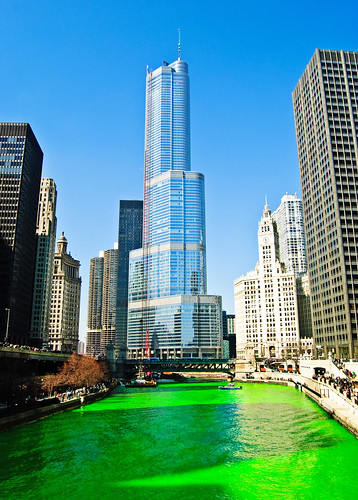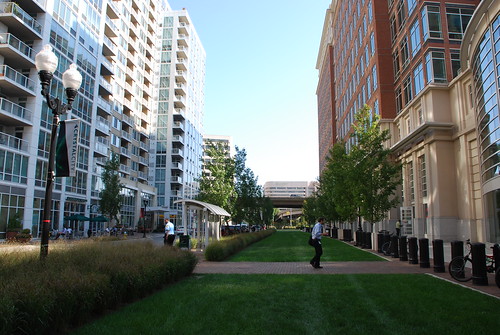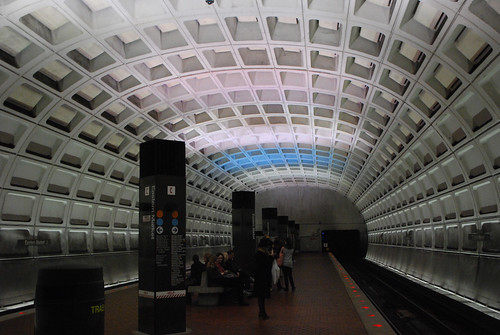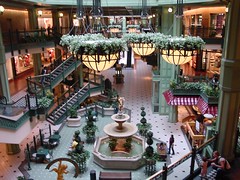|
Special Features





Image Libraries


|
|
Blog
What do Gallery Place, Van Ness, and White Flint all have in common? Originally they were mere Metro station names, but since being introduced they have all transcended to become the names of entire neighborhoods.
What do Tysons-McLean, Tysons I & II, Tysons Central, and Tysons-Spring Hill Road have in common? They are proposed Metro station names that will never, ever do the same. Maybe if people drop the “Tysons” part of each name and just use the second half colloquially, but even then it’s hard to imagine anyone calling a neighborhood “I&II”.
Yesterday, Fairfax County’s Board of Supervisors approved its recommendations for the 8 new Metro stations that will open in Fairfax as part of the Silver Line. The names are, in a word, terrible. The four stations in Tysons Corner are particularly unfortunate, because the county is engaged in a long term plan to remake Tysons as an urban center. Suburban park and rides might not need distinctive names, but urban neighborhoods do, and in this way Fairfax is utterly failing its own agenda for Tysons Corner.
I’ve discussed this before, as has GGW, but the proposed names for Tysons are so mind-bogglingly bad that they really do merit response.
What sort of names might better define the urban neighborhoods Fairfax hopes to create in Tysons Corner? How about any of the following, all named after neighborhoods, parks, or roads in the vicinity of the proposed stations:
| Fairfax Proposal |
Better Option 1 |
Better Option 2 |
Better Option 3 |
| Tysons-McLean |
Scott Run |
Dolly Madison |
Pimmit Hills |
| Tysons I&II |
Galleria Center |
Tysons Market |
International Center |
| Tysons Central |
Westpark |
Solutions Center |
Gosnell |
| Tysons-Spring Hill Road |
Spring Hill |
Raglan Park |
Ash Grove |
The good news is the WMATA Board has ultimate say over what these stations will be called, so there is still hope that they will ignore Fairfax’s recommendations in favor of station names that will convey some sense of place to the neighborhoods that are sure to grow around them.
But how likely is WMATA to overturn a local decision? And really, why should they? It’s not the Metro Board’s job to fix Tysons Corner.
Average Rating: 4.5 out of 5 based on 243 user reviews.
March 30th, 2011 | Permalink
Tags: government, metrorail, proposal, transportation

I took this a couple of weekends ago. The park is pleasant enough, but I think it’s a bit empty. More stuff would give more people more reason to visit. I’d like to see a couple of vendor carts and maybe something like a public boat house. The historic info displays that are placed as focal points are cool to have, but as focal points they’re lacking compared to more traditional public art.
Anyway, click the image for the full-size version.

Much, much better than what was there before.
Average Rating: 4.4 out of 5 based on 273 user reviews.
March 29th, 2011 | Permalink
Tags: galleries, urbandesign

Census results say the District is rapidly losing its black majority, which has Marion Barry rather upset. He says:
“We’re going to stop this trend — gentrification… I believe in integration, but I don’t believe in the apartheid we have in Ward 8.”
Barry went on to refer to Prince George’s County as “Ward 9″ because so many of the District’s former residents have moved there in recent years.
As a white person I feel stuck between a rock and a hard place when it comes to gentrification, because it seems like no matter what I do, I’m the bad guy. First white people were bad guys for abandoning the city, now white people are bad guys for coming back, except in Ward 8 where white people are bad guys for not coming back. ‘We’ve got to stop gentrification, but we’ve got to do something about the lack of integration in Ward 8′. Uhhhh…
Anyway, I thought Barry’s Ward 9 comment was interesting, but also potentially applicable to more places than just Prince George’s County. Arlington is an obvious contender, since it’s dense and urban and, y’know, it used to be part of DC. Maybe arguments could also be made for Silver Spring, or Baltimore, or – who knows – Denver.
So I put together the little survey attached. What do you think?
Average Rating: 4.8 out of 5 based on 217 user reviews.
March 25th, 2011 | Permalink
Tags: question, social

The National Building Museum tweeted this morning “Mathematician Blaise Pascal organized the first public bus line in 1662.”
Neat! But awfully vague. I went looking for more details, and found them in a 2008 article from Wired, which explains:
“The system started with seven horse-drawn vehicles running along regular routes. Each coach could carry six or eight passengers. Some sources specify three routes; others say there were six, and that one of them was a circular route.
The Carosses à Cinq Sous, or Five-Penny Coaches, were popular at first, but the novelty soon wore off. The system proved an idea ahead of its time. France was still a feudal society, with the Sun King at its apex. Nobility and gentry were allowed to ride the coaches, but not soldiers and peasants. The bus routes were out of business by 1675.
Regular bus service didn’t return to Paris until the early 19th century. Stagecoaches running short routes also began service around that time in London and New York City.”
So there you have it: Urban bus service in Paris 250 years before anybody thought to try it elsewhere. I wonder if the routes are mapped anywhere, or if that information is lost to history.
Average Rating: 4.8 out of 5 based on 288 user reviews.
March 22nd, 2011 | Permalink
Tags: bus, history, transportation

|

Radiation doses from a variety of sources.
Image from xkcd.com. |
Question: How might the disaster in Japan kill thousands of Americans? Answer: If anti-nuclear knee-jerk reactionaries are successful in using the Japanese tsunami as political leverage to scare Americans from investing in more nuclear power.
How so? Because every year 30, 000 Americans die from causes related to coal power production. Thirty thousand. That’s more dead Americans every year than in the entire Revolutionary War. It’s five times as many dead Americans as the Iraq and Afghanistan Wars combined. It’s almost twice the 18, 000 estimated Japanese dead from the tsunami disaster.
The longer we use coal instead of nuclear for the majority of our power generation in this country, the more Americans will die.
While we’re on the subject, let’s also talk about how dangerous the nuclear situation in Japan actually is. The chart at right is a snippet from a much larger one comparing radiation doses received for a variety of events. Note that the additional radiation doses received by Japanese citizens in villages near the breaking-down nuclear plant average less than a normal day’s dose (which is to say, they’re getting less than twice the normal daily dose that you get simply by living on the surface of the Earth). They’re less than you get from a dental x-ray, and much less than you get by flying on a jet from New York to Los Angeles.
It’s true that a relatively small number of workers at the plant are getting much higher doses, but the danger to the mass population is quite low. Meanwhile, thousands of people around the world continue to die every day as a result of coal power production. Far more than will ever die as a result of nuclear radiation from any of these Japanese plants. The 30, 000 American deaths per year attributed to coal average to more than 80 per day, which is nothing compared to the average of almost 1, 400 per day from China’s half-million annual coal deaths.
I don’t mean to imply that we should treat nuclear power lightly. Of course the only reason it’s so safe is that tremendous safety measures are involved. We should absolutely learn from the disaster in Japan to improve safety however possible. But one thing we cannot afford to do is allow knee-jerk reactionaries to stop America from expanding our nuclear production capacity. The human toll of such narrow thinking would simply be too great.
Average Rating: 4.6 out of 5 based on 244 user reviews.
March 21st, 2011 | Permalink
Tags: energy, environment, history

A 1400-foot-tall skyscraper and a river dyed green.
Happy Saint Patrick’s Day.

Photo of Trump Tower Chicago and the Chicago river dyed green by flickr user multisanti.
Average Rating: 5 out of 5 based on 228 user reviews.
March 17th, 2011 | Permalink
Tags: fun, galleries

Arlington and Alexandria are working on a dedicated transitway that will run in from Pentagon City Metro to Braddock Road Metro. The Crystal City – Potomac Yard Transitway project is comparable in many ways to DC’s K Street Transitway. They will both provide dedicated busways, and both will probably be upgraded to streetcar eventually.
There is one key difference, however: The CCPY transitway is much closer to reality. In fact, large portions of its right-of-way are already in place, having been dedicated by developers of recent new buildings.
The transitway isn’t ready to be used by actual buses or trains, but the portions on the ground today are nonetheless a fascinating preview of what’s to come. Looking at this picture – or standing there in person – it’s easy to imagine the next generation of transit rolling down this grassy strip:

Average Rating: 4.4 out of 5 based on 244 user reviews.
March 16th, 2011 | Permalink
Tags: BRT, government, transportation

I like this, as seen Sunday at Eastern Market station. Metro’s famous vaults are genius, but a little more color and variety between them would add a lot. This a wonderful solution.
I have no idea what the explanation is for this. Is it a Metro program? Is it just a temporary trick of the lights? If you know, please drop a comment.

Average Rating: 4.9 out of 5 based on 175 user reviews.
March 15th, 2011 | Permalink
Tags: fun, galleries, metrorail, transportation

An ill-advised attempt to shave $3-5 million in spending from WMATA’s budget might actually cost the agency $300 million in revenue.
In response to WMATA’s proposal to end late night trail service, the District of Columbia is considering withholding $50 million in maintenance funding, which would actually put a total of $300 million in danger because doing so might trip up $250 million in funds coming from MD, VA, and the federal government
While I don’t think actually withholding the money would be a good idea, I do think the threat to do so sends an important message to WMATA leadership: For the District of Columbia, Metro is not a commuter railroad. It’s the lifeblood of the city, and we cannot do without it. If Metro won’t run a service that actually responds to the needs of the District, the District will have no reason to continue funding Metro.
This all comes down to new WMATA General Manager Richard Sarles. Sarles spent years at New Jersey Transit, which means he has tremendous experience managing an aging network of commuter rail lines in need of serious maintenance. Obviously those are skills that Metro needs right now, in the wake of 2009’s safety problems. On the other hand, it also means that Sarles may not fully understand Metro’s mission, and may be prone to thinking in “railroad-head” terms with a focus on moving trains rather than people. If Sarles is going to be an effective manager at Metro for any length of time, he will need to expand his frame of mind to accept Metro’s more comprehensive mission. We need the expertise he has in maintenance, but that isn’t enough on its own.
Average Rating: 4.6 out of 5 based on 156 user reviews.
March 11th, 2011 | Permalink
Tags: government, metrorail, people, transportation

Georgetown Park Mall may be redeveloped to house Bloomingdale’s and Target department stores.
This is great news, because frankly it’s offensive that there’s a suburban-style enclosed mall in an urban neighborhood like Georgetown. The idea made some sense when the mall opened 1981, when it seemed as though suburbanization was the only way to save the city from decline, but in the context of a basically healthy and walkable city, it’s absurd. The market reflects the mall’s basic absurdity, as its only desirable retail spaces are those that front the M Street sidewalk; the interior spaces are occupied by such glamorous retail offerings as the DC DMV.
On the other hand, I can’t think of a better use for a large enclosed space in Georgetown than a couple of department stores. Georgetown has long had an impressive collection of boutique shops, but it has also always lacked a major retail anchor. It’s always been cute, but from the perspective of pure shopping it has always been incomplete, and thus it has always lost customers to suburban options like Tysons Corner. The presence of Bloomingdale’s and Target in Georgetown will make it a more comprehensive and practical place for city residents to do their shopping. It will give us good places to buy oven mitts and underwear.
I hope the deal goes through.
Average Rating: 4.4 out of 5 based on 227 user reviews.
March 10th, 2011 | Permalink
Tags: development, urbandesign

|
Media





Site
About BeyondDC
Archive 2003-06
Contact
Category Tags:
Partners
|



















